Agha Waseem Ahmed and Zubair Shafi Ghauri
For a long while I kept listening to terminologies like Paleolithic, Mesolithic, Neolithic, Pre Indus, Mature Harrapan civilizations and so on. Though the subject was very interesting for a layman like me but I never thought of listening to such eccentric jargon when we planned to visit Lakhan Jo Daro and met Pof. Dr. Ghulam Mustafa Shar of Archaeology Department, Shah Abdul Latif University, Khairpur.
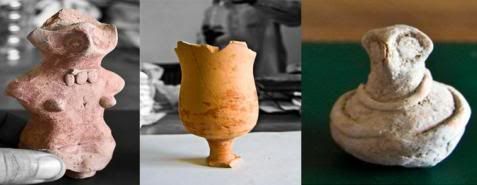

Lakhan-jo-Daro is a Sindhi word and it means The Hill of Lakhan in English and ‘Lakhan ka Teela’ in Urdu. Going by the same nomenclauture you can also guess what the famous site Mohen-jo-Daro means.
Few months back news surfaced in international media about an ancient archeological find near Sukkur. Just in days “Lakhan Jo Daro†was a common word. Everybody was chanting “LJD†and its importance in the Archeological arena.
There were claims about its seniority in the league of ancient civilizations. Mohen-Jo-Daro. Mehar Garh, Harappa and all Mesopotamian cities seemed college freshman. But the news faded in oblivision and “LJD†no more finds a place in print or online media. What happened to “LJD� Why the excavations are at a halt? Why a National treasure is lying unearthed and how the Land Mafia is running amok to occupy and construct over a piece of land, supposed to be protected by Federal and Provincial Governments?
Earlier reports explain that the area was in the knowledge of archaeologists of Shah Abdul Latif University, since the early 1980s and to local, provincial and federal officials as well as to international experts since 1988, some Italian experts visited the area during the mid-90s tested some organic material from Lakhan Jo Daro and relevant C-14 carbon results at Centre for Isotope Research at the Dutch University of Groningen in 1997 dated the samples to be about 3,960 years old.
The test data related to only the uppermost crust that was scratched at the time. Since then more findings have been made and parallels can be easily drawn with the period of Mohenjo-Daro.
It was one of the “Hottest days†in Sukkur reaching 50 Degree Celsius. Mercury in Met offices’ thermometer must have rocketed to outer space but what the hack, curiosity kills the cat, our destination was Lakhan Jo Daro near Village Nihal Khoso in the vicinity of Sukkur (some 40 kilometers north of Kot Diji and about 120 kilometers southwest of Mohenjo-Daro.)
Our team was headed by Mr. Zubair Shafi Ghauri, an eminent historian/archeologist from Lahore. On way to “LJD†our one sided conversation was heavily filled with the kind of lexicon Dr. Ahmed Hassan Dani and Dr Rafiq Mughal might have used in their classes with their pupils. By the end of our journey I almost forgot about my profession and started to think about a career in archeology but it was just the beginning, more was to come ahead.
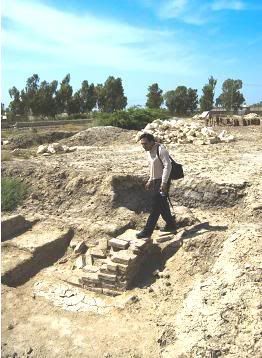 To our abject disappointment “LJD†was offering open access to all and sundry. There was no sign board or demarcation of the area. In the absence of any boundary wall the unguarded, precious area was harboring cattle etc and offering scattered Archeological treasures, very much visible on account of recent unfinished excavations for plundering. Construction of factories and residential buildings around the area was very much underway and a lot of building debris was scattered over the Archeological rubbles.
To our abject disappointment “LJD†was offering open access to all and sundry. There was no sign board or demarcation of the area. In the absence of any boundary wall the unguarded, precious area was harboring cattle etc and offering scattered Archeological treasures, very much visible on account of recent unfinished excavations for plundering. Construction of factories and residential buildings around the area was very much underway and a lot of building debris was scattered over the Archeological rubbles.
Baked brick foundations, walls and staircases leading to unexcavated depths were all around. It was very easy to envision a once highly civilized populace inhabiting the God forsaken place. Pieces of pottery, bangles, toys etc could be seen just within the reach. Mr. Ghauri opined that these artifacts (over the surface) were not older than Mohenjo-Daro and belonged to early & mature Harrapan phases of the Indus Civilization. Banded pottery of the early Harappan or Kot dijian period alongwith perforated and black on red pottery were giving clear indication of this phenomenon (this was later on testified when we met Dr. Shar).
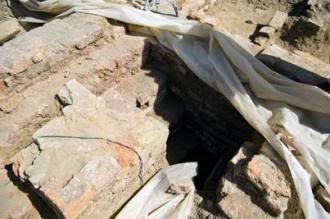 While, we were roaming around the remains a number of people gathered around, telling us stories of conflicts about the right of ownership over the piece of land and Antiquity thefts. It was a sorry state of affairs and we returned with a dejected heart to meet Dr. G.M Shar, very next day. Our meeting was arranged by one of our team members Mr. Habib Sajid a post graduate of Archeology from Shah Latif University.
While, we were roaming around the remains a number of people gathered around, telling us stories of conflicts about the right of ownership over the piece of land and Antiquity thefts. It was a sorry state of affairs and we returned with a dejected heart to meet Dr. G.M Shar, very next day. Our meeting was arranged by one of our team members Mr. Habib Sajid a post graduate of Archeology from Shah Latif University.

Shah Latif University, Khairpur is a young and flourishing AlmaMater, acquiring respect and status of a reputed campus on account of its committed teaching faculty. Dr. G.M Shar. Ex Chairman Archeology Department is one such faculty member, who does not believe in just imparting theoretical knowledge but engages his students in field research. Raised in Khairpur and received his doctoral degree from Germany, Dr. Shar is a noble soul, a humble man having firm belief in the archeological richness of his land.
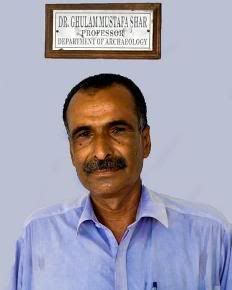 He greeted us with a candid smile and a warm hug. Over the cup tea, proud of our common heritage he explained that the Indus civilization is the oldest of all contemporary civilizations of the pre-historic era. Indus men of Mohenjo-Daro and Harappa had trade links with Sumer, Ur, Mesopotamia and Egypt.
He greeted us with a candid smile and a warm hug. Over the cup tea, proud of our common heritage he explained that the Indus civilization is the oldest of all contemporary civilizations of the pre-historic era. Indus men of Mohenjo-Daro and Harappa had trade links with Sumer, Ur, Mesopotamia and Egypt.
7000 years ago the Mehargarhian were the first agriculturalists in South Asia and 5000 years ago people of the Sukkur district were building brick cities unequaled in the world, used a pictographic language, were not vegetarian, buried their dead, ate beef, lived in un-stratified housing, had no caste system. etc. Talking about his archeological finds at “LJD†he said that though the site was known since 80s to many Archeologists, however, considerable attention was never paid since the last carbon tests in 1997. While he was chairman of the Archeology Department, in January 2009 , a team of 22 students and faculty from the Archeology Department, S.A.L. University started excavation of what now is known as “Lakhan Jo Daroâ€.
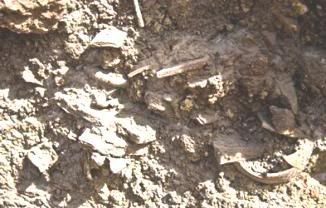 Regarding Mr. Ghauri’s observation about the early & mature Indus/Harrapan status of “LJD†he verified and added that there are layers of various strata at “LJD†and at the surface one can find signs of comparatively younger civilization but deep down the earth, his team found seals, some semi-precious and precious stones and utensils made of clay, copper and other metals and other artifacts that date much earlier than Mohenjo-Daro and Mehargarh. However, as most important of the articles of interest were kept in safe custody, Mr. Ghauri was not in a position to form a final opinion on this issue. According to him, the artifacts shown to us like terracotta wheels of toy cart, stone weight, terracotta figurines, a typical jar of Harrapan nature, a fragmented tile having circles and hatched leaves, a top, frame of a toy cart and a pot having buff slip with circles of parallel lines in black, all were related to the early & mature Indus tradition and nothing was precisely associated with the Mehar Garh tradition.
Regarding Mr. Ghauri’s observation about the early & mature Indus/Harrapan status of “LJD†he verified and added that there are layers of various strata at “LJD†and at the surface one can find signs of comparatively younger civilization but deep down the earth, his team found seals, some semi-precious and precious stones and utensils made of clay, copper and other metals and other artifacts that date much earlier than Mohenjo-Daro and Mehargarh. However, as most important of the articles of interest were kept in safe custody, Mr. Ghauri was not in a position to form a final opinion on this issue. According to him, the artifacts shown to us like terracotta wheels of toy cart, stone weight, terracotta figurines, a typical jar of Harrapan nature, a fragmented tile having circles and hatched leaves, a top, frame of a toy cart and a pot having buff slip with circles of parallel lines in black, all were related to the early & mature Indus tradition and nothing was precisely associated with the Mehar Garh tradition.
Dr. Ghulam Mustafa further told us that remains of a ‘faience’ mirror factory were also found which are believed to be of the era of mirror factories of Italy. Talking about a painting found at “LJD†he established the connection of “LJD†with the remains found at Meher Garh in Baluchistan and Jericho in Palestine.
Over the issue of why the excavation has been stopped he said that it is just matter of few months to settle certain issues and the excavation will be restarted very soon. He was emanating immense zeal and resilience about near future excavation. We left the university campus with the re-established moral that one man with a clear conscience and a strong will can make the difference.
Photography by Agha Waseem Ahmed.



















































present condition of lakhan jo daro is worst becuase around the place is only rain water. some people of flood water make their tents which destroy the maximum archelogical points. i think its only in pictures rest ntohing.
Do accept my appreciation for the information given on this post. It has been rather informative to read about this penetration through the layers of soil belonging to our beloved `Terra MATER Pakistanum
Sind – A General Introduction
Waseem I proudly own a book on Sindh’s archaeological history. It is titled ‘Sind – A General Introduction’ by M.T. Lambrick. It was published University of Sindh Jamshoro in 1962. After I got the hint on ‘Lakha tribe’ from you, I went looking for any reference to it. ‘Lakhan jo Dero’ is not mentioned because that excavation is pretty recent but there is some material on ‘Lakha tribe’. I was surprised to know the Lakha tribes have been living in this area from pre-Islam days. This makes it very likely that more archaeological sites may be found near the present day excavations of ‘Lakhan do Daro’